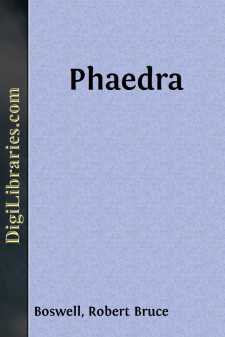Categories
- Antiques & Collectibles 13
- Architecture 36
- Art 48
- Bibles 22
- Biography & Autobiography 813
- Body, Mind & Spirit 138
- Business & Economics 28
- Children's Books 12
- Children's Fiction 9
- Computers 4
- Cooking 94
- Crafts & Hobbies 4
- Drama 346
- Education 46
- Family & Relationships 57
- Fiction 11821
- Games 19
- Gardening 17
- Health & Fitness 34
- History 1377
- House & Home 1
- Humor 147
- Juvenile Fiction 1873
- Juvenile Nonfiction 202
- Language Arts & Disciplines 88
- Law 16
- Literary Collections 686
- Literary Criticism 179
- Mathematics 13
- Medical 41
- Music 40
- Nature 179
- Non-Classifiable 1768
- Performing Arts 7
- Periodicals 1453
- Philosophy 64
- Photography 2
- Poetry 896
- Political Science 203
- Psychology 42
- Reference 154
- Religion 505
- Science 126
- Self-Help 81
- Social Science 81
- Sports & Recreation 34
- Study Aids 3
- Technology & Engineering 59
- Transportation 23
- Travel 463
- True Crime 29
Phaedra
Categories:
Description:
Excerpt
INTRODUCTORY NOTE
JEAN BAPTISTE RACINE, the younger contemporary of Corneille, and his rival for supremacy in French classical tragedy, was born at Ferte-Milon, December 21, 1639. He was educated at the College of Beauvais, at the great Jansenist school at Port Royal, and at the College d'Harcourt. He attracted notice by an ode written for the marriage of Louis XIV in 1660, and made his first really great dramatic success with his "Andromaque." His tragic masterpieces include "Britannicus," "Berenice," "Bajazet," "Mithridate," "Iphigenie," and "Phaedre," all written between 1669 and 1677. Then for some years he gave up dramatic composition, disgusted by the intrigues of enemies who sought to injure his career by exalting above him an unworthy rival. In 1689 he resumed his work under the persuasion of Mme. de Maintenon, and produced "Esther" and "Athalie," the latter ranking among his finest productions, although it did not receive public recognition until some time after his death in 1699. Besides his tragedies, Racine wrote one comedy, "Les Plaideurs," four hymns of great beauty, and a history of Port Royal.
The external conventions of classical tragedy which had been established by Corneille, Racine did not attempt to modify. His study of the Greek tragedians and his own taste led him to submit willingly to the rigor and simplicity of form which were the fundamental marks of the classical ideal. It was in his treatment of character that he differed most from his predecessor; for whereas, as we have seen, Corneille represented his leading figures as heroically subduing passion by force of will, Racine represents his as driven by almost uncontrollable passion. Thus his creations appeal to the modern reader as more warmly human; their speech, if less exalted, is simpler and more natural; and he succeeds more brilliantly with his portraits of women than with those of men.
All these characteristics are exemplified in "Phaedre," the tragedy of Racine which has made an appeal to the widest audience. To the legend as treated by Euripides, Racine added the love of Hippolytus for Aricia, and thus supplied a motive for Phaedra's jealousy, and at the same time he made the nurse instead of Phaedra the calumniator of his son to Theseus.
PHAEDRA
CHARACTERS
THESEUS, son of Aegeus and King of Athens.
PHAEDRA, wife of Theseus and Daughter of Minos and Pasiphae.
HIPPOLYTUS, son of Theseus and Antiope, Queen of the Amazons.
ARICIA, Princess of the Blood Royal of Athens.
OENONE, nurse of Phaedra.
THERAMENES, tutor of Hippolytus.
ISMENE, bosom friend of Aricia.
PANOPE, waiting-woman of Phaedra.
GUARDS.
The scene is laid at Troezen, a town of the Peloponnesus.
SCENE I
HIPPOLYTUS, THERAMENES
HIPPOLYTUS
My mind is settled, dear Theramenes,
And I can stay no more in lovely Troezen.
In doubt that racks my soul with mortal anguish,
I grow ashamed of such long idleness.
Six months and more my father has been gone,
And what may have befallen one so dear
I know not, nor what corner of the earth
Hides him....


